Exploring the intersection of spaceflight history, pop culture, and space art.
The previous installment of Creating Space covered a multitude of space-themed exhibits, pavilions, and fairground features at the 1964-65 New York World’s Fair. I teased at the end of that post that there was a whole other world of space to explore at the fair. Wait no longer, because we are now about to enter a place set aside especially for space exploration. It’s time to put on your silver spacesuit, secure your bubble helmet, and launch straight into the U. S. Space Park at the World’s Fair!
Are you new to Creating Space? It’s the NERDSletter that explores the intersection of spaceflight history, pop culture, and space art. You can find this and all other posts at creating-space.art.
Exploring More Space at the 1964-65 New York World’s Fair
When NASA and the U. S. Department of Defense came together to create an exhibit for the World’s Fair, they came up with something the scale of which most of the public had never before seen.
Still, the U. S. Space Park at the 1964-65 New York World’s Fair might have been easily missed by many uninformed visitors. Seeming almost as an afterthought, it was located in the extreme western corner of the fair, across a multi-lane parkway from the main part of the fairgrounds, hidden behind the massive Ford pavilion, and situated between a chartered bus terminal and the construction site of the New York Hall of Science.
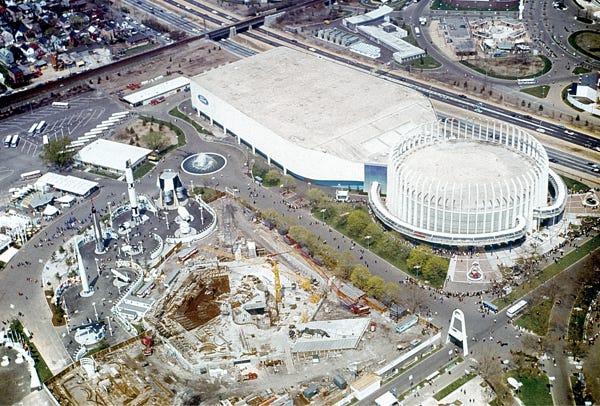
Nevertheless, the intrepid space-enthused fairgoer would have received great rewards should they have ventured over to the space reserved for the U. S. Space Park.
NASA, together with the U. S. Department of Defense, sponsored the U. S. Space Park and filled the 2-acre space with spacecraft, rockets, and satellites – both real and mockups. The most prominent (and noticeable from a distance) displays consisted of three towering full-scale rockets representing the then current launch vehicles for sending both satellites and men into space.
The tallest rocket was the 110-foot-high (33.5 m) Titan II missile topped with a mockup Gemini capsule. It represented the latest and greatest of NASA’s space program at the time. The first unmanned Gemini flight test launched two weeks prior to the fair’s opening. The manned missions were well underway the following spring and summer during the fair’s second season.
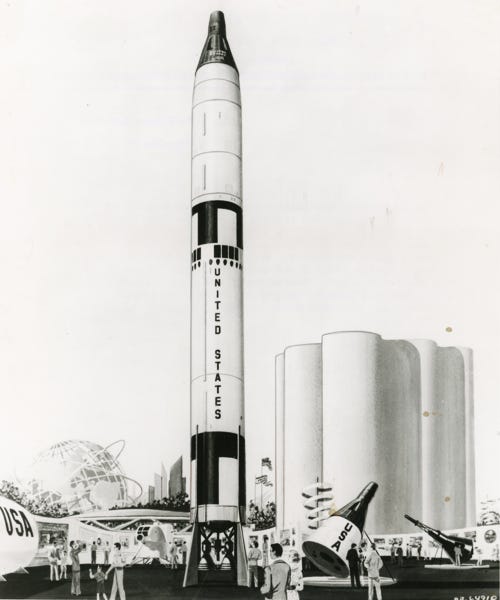
For the nostalgic among the fair’s visitors, an Atlas missile stood nearby with a Mercury capsule mockup. Project Mercury had sent the first six of NASA’s astronauts into space between May 1961 and May 1963. The 94.3-foot-tall (28.7 m) Atlas-Mercury hurled the final four capsules into Earth orbit.
Rounding out this set of launch vehicles was a Thor-Delta rocket, standing 101 feet (30.8 m) tall. The Thor-Delta launched a number of significant payloads, including the first communications satellite, Echo 1A; the first British satellite, Ariel 1; and the first active direct-relay communications satellite, Telstar 1.
Rocket Gardens and Rocket Rows
Had those three rockets been all that were displayed, they still would have made an impressive and novel sight to see. At the time of the fair, what we have since come to know as ‘rocket gardens’ were not yet commonplace.
The U. S. Space Park, as described by the 1964 World's Fair Information Manual, was “the first of its kind ever assembled.”1
The Space Park rivaled some of the more popular rocket gardens that would later launch in locations such as the Kennedy Space Center in Cape Canaveral, Florida, the Johnson Space Center in Houston, Texas, and the U. S. Space and Rocket Center in Huntsville, Alabama.
To put this in perspective, the Kennedy Space Center Visitor Complex began in 1963 as a humble trailer in which tourists could obtain information about the facility and set out on self-guided driving tours through the Cape Canaveral Air Force Station.
In 1965 – after the World’s Fair was into its second season – a full-scale visitor center was built at the Kennedy Space Center and christened “Spaceport, USA”. It covered 42 acres and later served as a launching point for TWA-operated bus tours. The displays outside of the visitor center consisted only of a few spacecraft mockups.
It wasn’t until around 1969 that the first three rockets appeared on the grounds of the visitor center. They were a Titan/Gemini (actually a Titan I made to look like a Titan II), a Jupiter-C/Explorer, and a Juno II launch vehicle.

The first ‘rocket row’ that I recall seeing in person was at the Smithsonian Institution in Washington, D.C. One of my earliest childhood memories is excitedly running ahead of my parents down the side street beside the Arts and Industries Building to get a closer look at the rockets. I doubt I knew exactly what they were at the time, but I knew they were impressively big and that they flew.
Standing guard outside the building were four missiles. There was a Jupiter C, configured with a mockup of Explorer I, the first U.S. satellite; Vanguard, which infamously did not launch America’s first satellite; a Polaris A-1, the first U.S. submarine-launched ICBM; and an Atlas ICBM.

Beyond the Rockets
In addition to the full-size rockets on display, the World’s Fair Space Park was filled with a multitude of spacecraft replicas and mockups, as well as one actual flown capsule.
Of particular interest to me are the Apollo mockups. Two years prior to the opening of the fair, NASA and its contractors had decided upon the Lunar Orbit Rendezvous approach for its manned lunar landing missions. By 1964, the vehicles that would be used were in the midst of engineering development. The Space Park presented visitors with the latest views of cutting edge space exploration technology.
The Saturn V rocket that would take men to the Moon, which would not have its first unmanned test flight until three years later, was represented by the bottom 52 feet (15.8 m) of the first stage. Referred to as the ‘boat tail’, the plywood mockup consisted of the five giant F-1 engines, their four fairings and fins, and a section of the first stage body.
The Command and Service Modules were represented by a mockup of the Block I configuration which was designed for Earth orbital missions, absent the docking probe and tunnel. When the fair opened, NASA was two years away from unmanned flight tests of this spacecraft.

A full-scale mockup of the Apollo Lunar Excursion Module rounded out the three vehicles meant to take humans to the Moon for the first time.
I find it interesting to see the artist’s concept of the LEM in one of the early sketches for the Space Park. Zooming into the Titan rocket illustration, near the beginning of this post, one can make out a somewhat simplified depiction of the 1962 Grumman proposal configuration – the one I call the “Bubble LEM”.

The Lunar Module’s design had gone through several iterations by 1964 and was going through its refinement stages. The World’s Fair mockup presented a configuration that still had a forward round docking/egress tunnel and lacked any ladders or other easy means for astronauts get down from (and back up to) the ascent stage.
When I look at this image, I imagine what it must have been like for a child seeing this alien-looking space vehicle for the first time. It would probably have taken all of my will power and self-control to keep me from trying to climb up the leg struts and crawl inside. Thinking back to how I was as a kid, I likely would have failed to restrain myself. Now, as an adult who collects space contractor models, I can’t help but wonder where this LEM mockup is now ... and how I could get it to my house!

In addition to the Apollo spacecraft displays, visitors to the Space Park could view a replica Gemini capsule, climb into a mockup Mercury capsule, and even be treated to the actual Aurora 7 capsule that took Mercury astronaut Scott Carpenter on his three-orbit trip around the globe on May 24, 1962.

The last of the piloted vehicles to be featured at the Space Park was the X-15 rocket-powered research plane. The X-15 program had begun in 1959 and was ongoing during the fair, and it extended until the end of 1968. The full-scale model was actually updated during the span of the exhibit as the X-15 program – and the vehicle configuration – progressed.

Perhaps the most unusual object in the Space Park was a so-called Space Shuttle. But, this was not your future grandson’s Space Shuttle. It was a concept for a six-foot-high, jet-propelled, one-man craft for hauling cargo and personnel between orbiting spacecraft. Its three mechanical arms could be used to assemble structures in space.

In addition to the manned space programs, quite a number of unmanned scientific satellites and probes were represented at the Space Park. The list is too long to cover every one in this forum. Suffice it to say that the collection included fifteen satellites, three lunar and interplanetary probes, two booster upper stages, and a nuclear electric power generation system for use on the Moon.
Taken all together, the number of spacecraft represented within the small space of the U. S. Space Park may rival or even exceed those displayed in the collections of many present day museums. It would have indeed been an impressive sight to behold.
Visitors from Outer Space
NASA took every opportunity to leverage the great popularity of the World’s Fair by sending astronauts and notable NASA officials to visit the Space Park. Astronauts Scott Carpenter (whose flown Mercury capsule was featured at the exhibit), Gordon Cooper, and Elliott See (who was among the group of astronauts selected for Project Gemini) all made appearances.

Wernher von Braun (director of NASA’s Marshall Space Flight Center), James Webb (NASA’s Administrator at the time), and John “Shorty” Powers (NASA public affairs officer) also came to the Space Park.

“I missed the whole thing!”
Buzz Aldrin famously quipped that he and Neil Armstrong “missed the whole thing”. He, of course, was joking about the fact that the whole world was watching their moonwalk while he and his crewmates had no television with them.
That is how I feel about the U. S. Space Park at the World’s Fair. I visited the fair with my family twice, when I was four and five years old, but I somehow have no recollection of seeing the Space Park. While this could be a gap in my childhood memories, I find it hard to believe that I would forget such a spectacle.

But, it wasn’t until I was well into adulthood, and the internet gave us the ability to travel into the past via countless online articles and photographs on virtually any subject, that I learned there even was such an exhibit at the fair.
I do know that I came very close to seeing the Space Park.
One of the exhibits in the transportation section of the fair was the Sinclair Refining Company’s Dinoland. Sinclair was the official provider of gas and vehicle lubricants for the fair. They created an exhibit featuring life-sized models of dinosaurs – some of which had motion features. The exhibit was geared mainly towards kids.
I must have been really into dinosaurs, like many kids my age, because one of the few memories I have of being at the fair is the Dinoland exhibit. Or, perhaps my interest was more motivated by mechanical objects, since the specific memory I have of the exhibit is actually the Mold-A-Rama machine that created an injection-molded plastic brontosaurus souvenir. I cherished my green brontosaurus and kept it for years after the fair. I even got my dad to repair it for me when its long, gracefully curving, yet fragile neck broke.

Sinclair’s Dinoland was not far from the Space Park. Dinoland can be found – on this detail from a souvenir map – near the middle right, next to the United States Rubber Company’s giant tire-shaped Ferris wheel. The U. S. Space Park is in the upper left corner, behind the Hall of Science. That’s less than a quarter mile away as the Dyna-Soar flies. So close … yet, so far!

Once I found out about the fair’s Space Park, I scoured through my father’s old slides seeking any evidence that we went to that part of the fairgrounds. Given my long-standing interest (OK, obsession) with the U.S. space programs, I could not imagine us skipping the Space Park!
My father also had an interest in NASA. I know, for instance, that he once applied for an illustrator job with the space agency. Someday, I will share the rocket painting he created to add to his portfolio for the interview. He was also very enthusiastic about photography. Those two interests got passed down to me, as well.
To my surprise, there were very few photographs of the World’s Fair in his archives – only about a dozen slides. Maybe he had brought only one roll of twelve shots. Most of the photos were of the Unisphere and surrounding scenery. There were a few others of me with my sister. It wasn’t looking good for finding Space Park pictures.
And, then I saw them! The last two slides taken at the fair were these two apparently haphazardly framed halves of the X-15 mockup. I had found my proof that (at least) he was at the Space Park!
It strikes me as strange that he would only have these two photos. Maybe they were the last two shots on the roll. Even odder, why frame his shots this way, slicing the X-15 into two halves? What becomes apparent upon closer inspection is that the rocket plane may not have been his primary subject. In each of the two slides there is the same helicopter approaching the heliport on top of the Port of New York Authority building. You can see that he took the left one first, centering the helicopter in the frame. Then he followed the helicopter as it neared the heliport before taking the second shot. The fact that he almost perfectly created a two-piece puzzle of the X-15 was perhaps an accidental bonus.
In what may be a sort of astronomical coincidence, one of the official postcards from the Space Park has an almost identical view of the X-15. Only, this photographer framed the subject a little better.
When I look at all of these images of the World’s Fair Space Park, I get an extreme feeling of yearning to go see and experience the exhibits. Given my current interest in spaceflight history, I find it hard to believe I missed such a spectacle of space hardware.
I would go back there to see it in a heartbeat if it was possible. I often say that if I had a Time Machine the first place in time I would visit would be the 1964-65 New York World’s Fair. And the first place I would go when I got there would be the U.S. Space Park.
Better Reliving Through Rendering
Since I don’t currently have a Time Machine, I had to get (literally) creative in order to satisfy my desire to experience the World’s Fair U. S. Space Park. I began modeling the park and its exhibits in 3D.
I started with the Apollo end of the park, and tackled the Lunar Module, first. I love the LEM, and it would fit right in with my growing series of lunar lander renderings.

You will recognize the scene from the photograph of the actual LEM mockup seen earlier in this post. This is still a work in progress, with some refinements yet to be done. I have also modeled the Command and Service modules and the Saturn V boat tail mockup.
I am not sure how far I will take it, or what the final form will be. But, the acts of researching and rebuilding the spacecraft in 3D are always great learning experiences. And, an added benefit of the exercise is that I am gaining a real sense of being there after all these years.

Art News
I will be exhibiting my space-inspired artwork at the U.S. Astronaut Hall of Fame Induction weekend events this year in Cocoa Beach, Florida. I will be joining notable space artists Chris Calle, Lee Wilson, and astronaut/artist Nicole Stott.

The events are organized by the Astronaut Scholarship Foundation (ASF), a non-profit organization that provides scholarships to the brightest and most talented college students in science, technology, engineering and mathematics.2 I am proud to be able to support the ASF in their educational mission. A portion of my sales proceeds will go directly to the ASF organization.
This year’s celebrations will be held from May 31 through June 1, 2024, marking forty years since the founding of the ASF. It will be my first time exhibiting at an astronaut event since Spacefest X in 2019.
My space-inspired art portfolio can be found at pixel-planet-pictures.com. You can also follow me on Instagram (pixelplanetpics).
Do you know fellow Space Geeks who might enjoy Creating Space? Invite them into this space, too!
Did you miss a post? Catch up here.
If you enjoyed this article please hit the ‘Like’ button and feel free to comment.
All images and text copyright © Dave Ginsberg, unless otherwise noted. All rights reserved.
1964 World's Fair Information Manual, nywf64.com


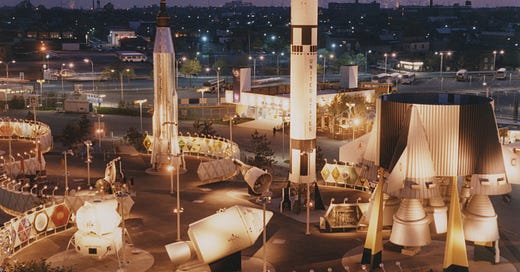


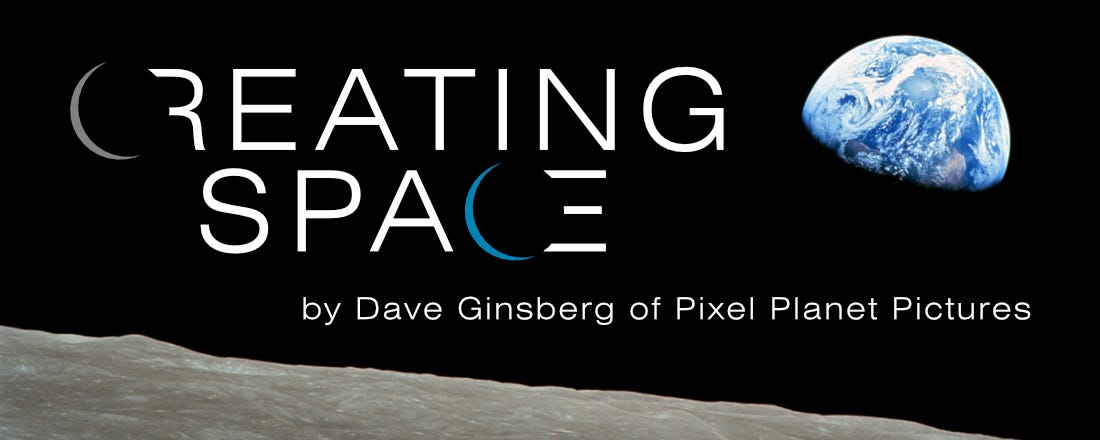









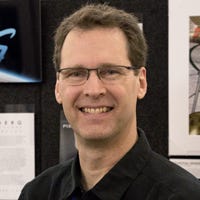


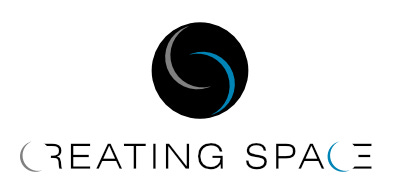
Thank you Dave for sharing your wonderful experiences with the fair stories! If a time machine is ever built I'd like to go with you to the fair back then! Also all the best and I hope you have an enjoyable time at the ceremonies coming up! I'm glad you have the chance to participate in that! Take photos when you can!